Elbląg- Warmian-Masurian 作者: 来源: 发布时间:2021-07-14
Ⅰ. Population and Area
Population (31 December 2019)
• Total 119,317 Decreases (32nd)
Area
• Total 79.82 km2 (30.82 sq mi)
Website http://www.elblag.eu
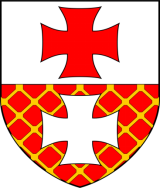
Ⅱ.Natural Geography (environment and resources)
Elbląg is located about 55 kilometres (34 miles) south-east of Gdańsk and 90 km (56 mi) south-west of Kaliningrad, Russia. The city is a port on the river Elbląg, which flows into the Vistula Lagoon about 10 km (6 mi) to the north, thus giving the city access to the Baltic Sea via the Russian-controlled Strait of Baltiysk. The Old Town (Polish: Stare Miasto) is located on the river Elbląg connecting Lake Drużno to the Vistula Lagoon, about 10 km (6 mi) from the lagoon and 60 km (37 mi) from Gdańsk. Two national roads run through the Elbląg ring road: the S7 connecting Elbląg with Gdańsk, Warsaw and Kraków, and the S22 being the shortest connection between the west and east of Europe.
Elbląg is also the largest port of the Vistula Lagoon. Situated on the Elbląg River, it provides coastal freight and passenger shipping on the Vistula Lagoon and the Baltic Sea.
Transport
The main element that distinguishes Elbląg from the entire voivodeship is its attractive geographic location
It is situated at the crossroads of all types of transport. It is an important international transport hub from east to west, connecting part of the Russian federation (Kaliningrad Oblast), with Poland and Western Europe (the S22 route connecting Berlin with Kaliningrad and further to Lithuania, Latvia, Estonia and Finland, belonging to the Trans-European Transport Network).
-The S7 expressway crossing and connecting cities such as Gdańsk, Warsaw, Kraków and Budapest also intersects here.
-Car communication enables trouble-free access to both large agglomerations in the vicinity of the city, such as: Gdańsk, Gdynia, Olsztyn, Bydgoszcz, as well as charming corners of the Warmia, Mazury and Pomerania region.
-Railway connections ensure communication, among others with Gdańsk, Tczew, Słupsk, Koszalin, Szczecin, Olsztyn, Ełk, Białystok, Warsaw, Malbork, Braniewo, Frombork, Berlin and Kaliningrad.
-Air connection :
-- Airport. Lech Wałęsa in Gdańsk-Rębiechowo, 40 minutes by car from Elbląg.
-- Olsztyn-Mazury Airport in Szymany , approximately 160 km from Elbląg.
-The water connection of Elbląg: due to the fact that it is located on the Elbląg river, they are very convenient and varied.
-Due to the connection with the Vistula Lagoon, it has access to the Baltic Sea, thus becoming the only Sea Port in the Warmińsko-Mazurskie voivodship. The proximity of the ports in Gdańsk, Gdynia, Kaliningrad and in the Scandinavian countries creates opportunities for comprehensive cooperation in the Baltic Sea basin. High hopes for the development of the Sea Port in Elbląg are related to the ditch of the Vistula Spit and free access to the Baltic Sea.
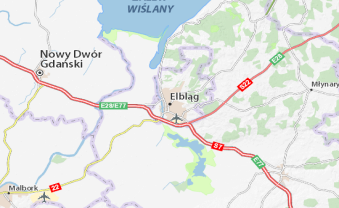
Ⅲ.Economy
Elbląg is an important industrial center, incl. heavy ( General Electric and FLSmidth MAAG Gear - Poland), food industry ( Browar Elbląg, which is part of Grupa Żywiec ), furniture (Meble Wójcik) and tourism ( Elbląg Canal with world-famous ramps )
City economy
Average monthly gross salary in Elbląg: PLN 4,044.35 (source: Tax Office Olsztyn on 31/12/2017)
Number of economic entities: 12,591 (source: US Olsztyn on 31/12/2018)
Economic entities by size classes:
0-9 people: 12 077 (source: US Olsztyn on December 31, 2018)
10-49 people: 402 (source: US Olsztyn on 31/12/2018)
50-249 people: 97 (source: US Olsztyn on December 31, 2018)
250 and more people: 15 (source: US Olsztyn on 31/12/2018)
Elbląg - A zone of good investments https://inwestycje.elblag.eu/
Ⅳ.Industrial Characteristics
-From the very beginning, Elbląg was an important economic, industrial, administrative and military center. The strength of Elbląg was the highly developed heavy industry - with foundries and machine factories, shipyards, steam locomotives and wagons factories. Especially in the second half of the nineteenth century, there was a clear revival in this respect. Weaving, dyeing and glazing developed. In addition, many agri-food and tobacco processing plants, soap factories and oil mills appeared. Shipbuilding was the main basis of the Elbląg industry. In 1837, one of the most distinguished citizens of Elbląg, Ferdinand Schichau, founded a machinery factory, and 17 years later a shipyard. Factories such as cigars, cars, Neufeld's metal factories and Tiessen's iron foundry were also pillars of the local industry.
-Currently, over 12,000 business entities operate in Elbląg, including over 100 with foreign capital. Many investors decide to be actively present in smaller agglomerations such as Elbląg, appreciating greater comfort and good quality of life, without the constant struggle and pressure that accompanies life in larger cities. The city enjoys the location of foreign companies in the electromechanical industry, modern business services, food and furniture.
-Leading industry in Elbląg:
-Metal, energetic, furniture, IT, food
-Elbląg - A zone of good investments https://inwestycje.elblag.eu/
-Key Projects
-1. Plan for the sustainable development of public transport for the Municipality of the City of Elbląg for 2017-2030
-Plan for the sustainable development of public transport for the Municipality of the City of Elbląg for 2017-2030 - The official website of the city of Elbląg. https://elblag.eu/index.php/plan-zrownowaonego-rozwoju-publicznego-transportu-zbiorowego-dla-gminy-miasto-elblg-na-lata-2017-2030
-2. A multi-year housing resource management program for the City of Elbląg for 2012 – 2020
-Long-term housing resource management program for the City of Elbląg for 2012 - 2020 - The official website of the city of Elbląg. https://elblag.eu/index.php/wieloletni-program-gospodarowania-mieszkaniowym-zasobem-miasta-elblga-na-lata-2012--2020
Ⅴ.Attrations and Cityscape
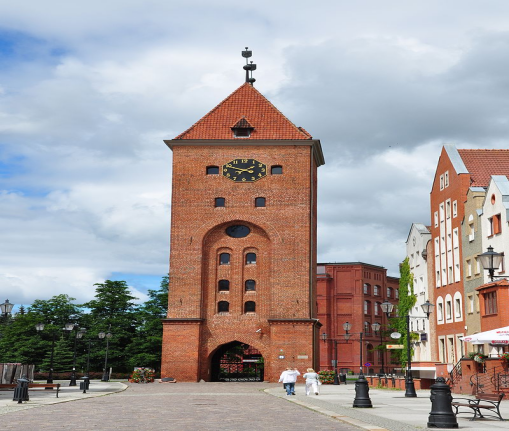
Market Gate, Old City
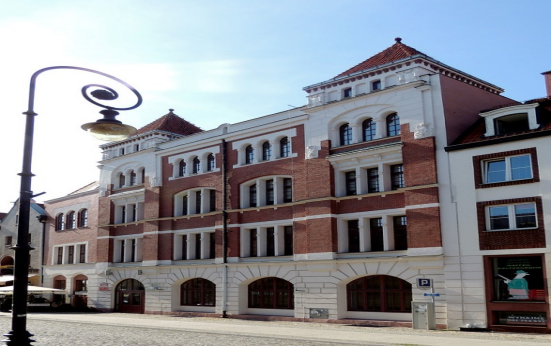
Holy Ghost Street, ulica Świętego Ducha, possesses several pre-war examples of social housing
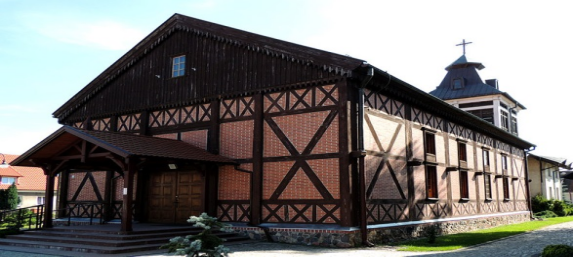
Timber-framed Holy Trinity Church
-Elblag is a medium sized port city inhabited by some 126,000 people. Since the end of the World War II the city has grown into a prosperous industrial, academic and cultural centre, drawing visitors from all over the world. Although before the war the city was much bigger and was one of the most important urban centres of the region, today’s Elblag is still significant due mainly to its shipyards, breweries and the thriving metallurgical industry. Moreover, in 1998 the city made a sizable step towards regaining its former grandness by initiating Euroregion Baltic – the union of six Baltic countries (Poland, Russia, Latvia, Estonia, Sweden and Denmark), aimed at cultural, political and financial partnerships.
-Elblag is also a historical site with numerous tourist attractions. Here you will find characteristic medieval red-brick tenement houses and churches, including the St. Nicolas Cathedral located in the Old Town district. Although the historical centre of the town combines the architectural styles of Gothic, Baroque, and Renaissance, almost none of its buildings are more than fifty years old because the Old Town suffered such extensive damage during World War II. In 2000, however, the local authorities decided to accelerate the reconstruction of the city and to cooperate with archaeologists in restoring the original prewar appeal of the city. Out of the meticulously reconstructed buildings the most imposing are the City Gate and St. Mary’s Church (turned into an art gallery).
-Elblag is located in Northern Poland, in the Warmińsko-Mazurskie voivodeship. The city lies on the Elblag River, which connects the nearby Lake Drużno to the Vistula Lagoon. The river is curbed by the Jagielloński and Elblaski Channels, which connect the town with nearby lakes and constitute a popular tourist attraction. The area surrounding the city belongs to the Vistula Delta (Zulawy Wislane) region, which is predominantly flat and used for agricultural purposes. To the west of Elblag there are extensive plains and open fields. The southern views are of the marshes and swamps that encircle Lake Druzno.
Ⅵ.History and Culture
-The beginnings of the city date back to 1237. It was then that the Teutonic Knights established a defensive castle on the banks of the Elbląg River. A trading settlement grew up around him. In 1246, it received the municipal rights of Lubeck. At that time, Elbląg was the seat of the national masters of the Teutonic Order.
-In the fourteenth century, Elbląg was an important port center, it belonged to the union of Hanseatic cities. The results of excavations carried out in the Old Town prove the wealth of the former inhabitants of Elbląg. Archaeologists extract thousands of products made of amber, ceramics, glass, metals, etc. They prove the existence of lively commercial contacts between the inhabitants of former Elbląg, among others with Germany, Scandinavia, England, the Netherlands.
-An important date in the history of the city was its accession to the Prussian Union in 1440. After the Battle of Grunwald in 1410, the inhabitants of Elbląg paid tribute to the Polish king Władysław Jagiello by offering him the captured Teutonic castle. However, it was only after the peace of Toruń in 1466 that Elbląg became part of the Polish state. The city received numerous privileges from Polish kings and became an important seaport. The wars that swept through these areas in the 16th and 17th centuries brought plagues, plunder and contributions.
-After the first partition of Poland in 1772, Elbląg was incorporated into the Prussian state. The city revived in the 19th century. Elbląg found itself on the railway route. The Elbląg Canal was put into operation. Established plants, incl. brewery, cigar, locomotive and car factory. However, the shipyard founded by Ferdinand Schichau was of particular importance for the city. In Elbląg, among others, torpedo boats, submarines and locomotives.
-In 1945, the city returned to Poland. As a result of hostilities, Elbląg was destroyed in about 65 percent. The Old Town suffered especially. Historic tenement houses fell into ruins. Others, damaged, were dismantled. Most of the inhabitants of Elbląg left the city. The displaced persons took over the reconstruction efforts. New workplaces and housing estates have been established in recent years. Thanks to the initiative of the city authorities, the Baltic Euroregion was created in 1998 - one of the largest Euroregions in Europe, of which Elbląg is a member.
-Elbląg, currently 124 thousand inhabitants, it is located on the river of the same name, in the north-western part of the Warmia-Masuria Province, near the Vistula Lagoon. It is situated on the road no. 7 Warsaw-Gdańsk, and at the so-called "Berlince" - road to Kaliningrad, 60 km from Gdańsk, 50 km from the Polish-Russian border and 100 km from Kaliningrad. Elbląg is a dynamically developing city with poviat rights, an industrial, academic and cultural center, an attractive starting point for tourists. It is also a seaport.
-For his achievements in environmental protection, he was twice honored - as the first city in Poland - with the "ecological" award of the European Union. The Council of Europe, on the other hand, gave it the Flag of Europe. He is also a three-time winner of the national competition "Environment-Friendly Community" under the patronage of the President of the Republic of Poland, Aleksander Kwaśniewski. He also received an award from the Union of the Baltic Cities for the implementation of the environmental education program.
-The leading industrial plants in Elbląg are Alstom Power Sp. z o. o. (producer of steam and gas turbines, toothed gears and heavy steel and non-ferrous metal castings), Żywiec SA Group brewery, Mazurskie Meble International. There are also companies of Holding Elzam (production of steel structures and metal processing) and other enterprises in the furniture, leather and clothing industries.
-The city is active in the international field. On the initiative of its authorities, in 1998, the Baltic Euroregion was established, gathering the coastal regions of six countries lying on the Baltic Sea: Russia, Poland, Sweden, Lithuania, Latvia and Denmark. Elbląg cooperates with 14 partner cities. These are: Kaliningrad and Baltiysk (Russia), Leer (Germany), Ronneby (Sweden), Navahrudak (Belarus), Druskininkai (Lithuania), Ternopil (Ukraine), Liepaja (Latvia), Compiegne (France), Trowbridge (England), Coquimbo (Chile), Baoji (China), Tainan (Taiwan), Nowy Sącz (Poland).
-The City Council of Elbląg, striving to attract domestic and foreign investors, adopted a resolution on reliefs for companies creating new jobs. Future investors can also benefit from the relief when deciding to locate their facilities in the Elbląg sub-zone of the Warmia and Mazury Special Economic Zone.
Ⅶ.Other Information
As a city with a bitter-sweet past and seemingly bright future, Elblag has always been an accurate indicator of Polish-German relationships. The town came into existence thanks to the close cooperation of Poles and Germans, but suffered great injuries whenever the two neighbouring nations entered into a state war. The contemporary Elblag bears witness to both periods and takes pride in its dual ancestry. That is why here you will find magnificent medieval monuments created mutually by the two nations and the remnants of an Old Town district almost completely destroyed during World War II.
Ⅷ.Contact Information
Mayor Witold Wróblewski (PSL)
Tel.: + 48 55 239 33 33
Fax: + 48 55 239 33 30
Location: Main building "A", 1st floor, room no. 210
E-mail: Prezy@umelblag.pl
